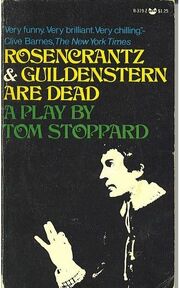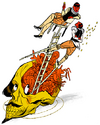
Rosencrantz and Guildenstern Are Dead is a 1966 play by Tom Stoppard. It is an existentialist tragicomedy and is part of the Theater of the Absurd movement. It expands upon the stories of Rosencrantz and Guildenstern, two minor characters from William Shakespeare's Hamlet. In this play, Rosencrantz and Guildenstern are the main protagonists and Hamlet is the bit player, thus making it the inverse of the original play. The action of the play focuses on the misadventures of Rosencrantz and Guildenstern while they were offstage in Shakespeare's version, except for a few scenes in which the dramatic actions of the plays coincide. In these scenes, Shakespeare's script is used by Stoppard verbatim. These scenes are in iambic pentameter; the rest of the play is in prose.
The two protagonists are portrayed as fools, ineptly stumbling through a world of intrigue which they are unable to understand even after clumsily debating various philosophical questions, with no conclusions. In the climax of the play, they attempt to deliver Hamlet to his death in England on Claudius' orders, but Hamlet escapes when their ship is seized by pirates and, as in Shakespeare's play, it is Rosencrantz and Guildenstern who are killed by the English. In their final scene, some small insight into the nature of the universe at last dawns on them, but it is a rather stark realization: Their feeble attempts to control their own lives never had a chance of derailing their predetermined destinies.
Rosencrantz and Guildenstern Are Dead in "We Haven't Got There Yet"[]
The centennial performance of Tom Stoppard's Rosencrantz and Guildenstern Are Dead was celebrated by the London theater scene in 2066. One company which had flown to the city to take part in the festivities was inexplicably transported back to London, but in the year 1606. They performed Rosencrantz and Guildenstern Are Dead and other plays they knew, including Waiting for Godot, at The Rose.
Rosencrantz and Guildenstern Are Dead confused many London theater-goers by its dismissal of Elizabethan-Jacobean play-writing conventions: It was three acts, written in prose rather than iambic pentameter (except for the scenes borrowed from Hamlet), disregarded the need to set the stage with a very dramatic opening, included many lines which would normally be censored by the Master of the Revels, had a very subtle plot that focused on existentialist questions, and offered only occasional excitement over long periods of inactivity. Most scandalously, it cast women in female roles, though this was not readily apparent as long as the actresses remained in costume. Despite this, or perhaps because of it, a substantial portion of London's theater-goers were intrigued.
The players were surprised, but only moderately so, when after one performance of the show, they were visited by William Shakespeare himself. Shakespeare had originally intended to confront Stoppard over his plagiarism, not realizing that Stoppard was not to be born for another three centuries. Instead, Shakespeare was very impressed by the play and sought to compliment the actors and the playwright - until the implications of dealing with people from the distant future disturbed him to the point that he fled their company.
See Also[]
- Performance Arts References in Turtledove's Work for more minor references.
- Waiting for Godot, a French play which is considered a possible influence on this one.
| ||||||||||
